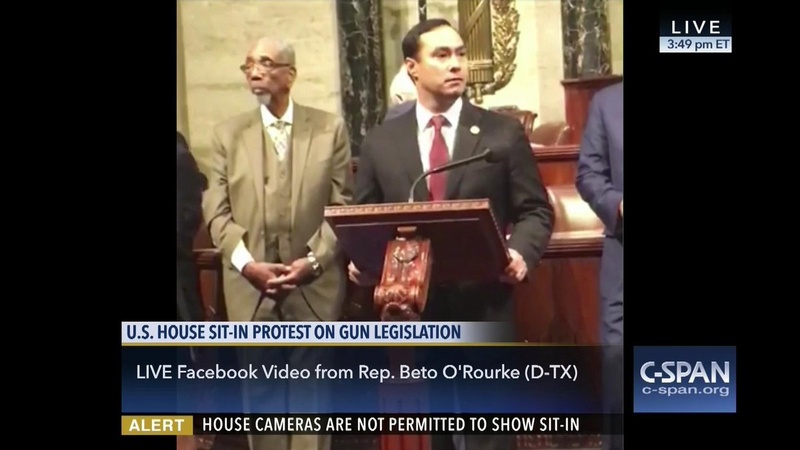Turning off C-SPAN feed troubling for transparency

When word spread that Democrats were staging a sit-in on the floor of the House of Representatives over a vote on gun legislation, like many Americans, Sunlight staff turned C-SPAN, one of the most reliable sources of nonpartisan information about government, to see what was happening.
When we tuned in, however, we found the national public affairs network was running a crawl that the cameras in the House had been turned off by the majority party of the House.
Here’s how it works: C-SPAN does not own or operate any of the cameras, it simply broadcasts the “feed” of events. The House recording studio owns and operates the cameras, meaning it controls the video, the audio and the camera angles. C-SPAN simply takes that video feed and broadcasts it. “Independent, non-government TV cameras (are) not allowed to broadcast regular floor proceedings (neither House nor Senate),” C-SPAN Communications Director Howard Mortman told us in an email.
Mortman also wrote that C-SPAN has a lengthy history of asking for greater access. You can read the organization’s letters on its website, which show they have been asking to install cameras since 1994.
WATCH: @repjohnlewis & @HouseDemocrats stage sit-in. Note:C-SPAN has no control over the U.S. House TV cameras. https://t.co/sz7ICdfhfv
— CSPAN (@cspan) June 22, 2016
This conflict of interest in who controls the cameras seems to be an ongoing problem. Today, that decision was made by Republicans, but in 2008, then-Speaker of the House Nancy Pelosi took the same action during a debate on an energy bill. Both of these instances are cause for concern.
Selective transparency in broadcasting action on the floor contradicts the constitutional principles that House Speaker Paul Ryan recently published and embraced. Americans on both sides of these issues have a vested interest in seeing which House members were taking part, what was playing out on the House floor, and being informed about the content of the debate over how the Second Amendment should be interpreted.
Representative democracy only works when people can see how their government is conducting business and, in turn, hold politicians accountable for those actions. C-SPAN’s camera coverage is a valuable tool in that process.
In an age of limited resources, there are many organizations and news outlets that depend on that livestream of events. At any time, you can tune in and see what is going on in American government as it is happening. The live broadcast allows you to watch events as they unfold, consider the information and make your own opinions about what is happening, free from cable news pundits talking over speeches on the floor and cutting away from the debate. You can go back in C-SPAN’s archives and see exactly what people said and in what context they said it. You can see how your representatives act and vote in real time.
C-SPAN is offered as a public service, and is perhaps one of our finest areas of transparency.
Shutting off the cameras sends a terrible message to other countries with new, struggling democracies that you cannot trust your people to evaluate the actions of their government. Instead, it shows that even in the Land of the Free, censorship is utilized to minimize the voice of the opposition.
While some lawmakers are using social media and livestreaming apps on their smartphones to route around the shutdown, demonstrating how technology has leapfrogged the single point of control of the “official feed,” the structural issue of political control of the cameras remains.
In an unprecedented move, C-SPAN switched to the Periscope feed of a congressman this afternoon, and then to a Facebook Live feed of another. The fact that advances in technology enable members of Congress to route around censorship of the House floor, however, does not mitigate the decision to shut down the C-SPAN cameras.
Some lawmakers ignored the “independent camera” rule — which bans using devices for still photography, audio or video recording — and started broadcasting via Periscope. C-SPAN switched to a Periscope feed this afternoon:
C-SPAN switches to Periscope live stream after House cameras shut off https://t.co/zoZArGskQ6 pic.twitter.com/6qkkmVhIaR
— Cory Bergman (@corybe) June 22, 2016
It is troubling that the cameras were not turned back on when it was clear this was something the American public would have an interest in observing. If you agree, we encourage you to use our tool Email Congress to let your lawmakers know.

